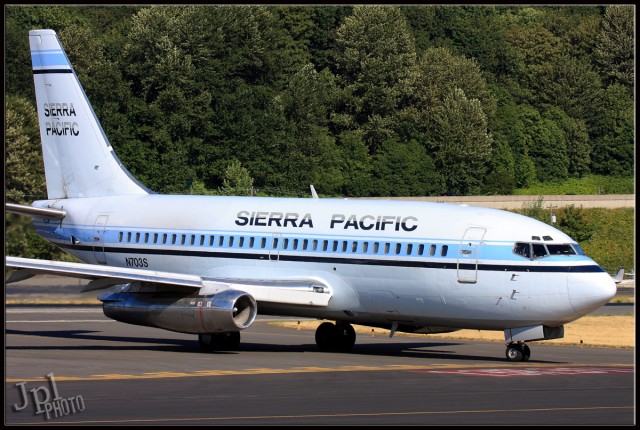
Sierra Pacific Airlines Boeing 737-200 taken at Boeing Field (BFI). Photo by Jeremy Dwyer-Lindgren.
I am always game for an airline in the US operating with a few classic Boeing 737-200s. It is rare to find one still operating in the US and soon, it will surely be impossible.
Sierra Pacific Airlines was founded in 1971 and currently operates two 737-200s (N703S and N712S) out of their base in Tucson, AZ. The airline runs charters and sub-charters for other airlines, while also running flights for the US Forest Service, US Military and the US Marshals.
Like most classic airliners, comes a classic livery and Sierra Pacific is no different. The livery rocks that cheat-line that is not seen on many of today’s modern jets.
Seeing this livery next to others a bit more modern, it comes up a bit short. Yet seeing it as an historical package, how can one not like it?
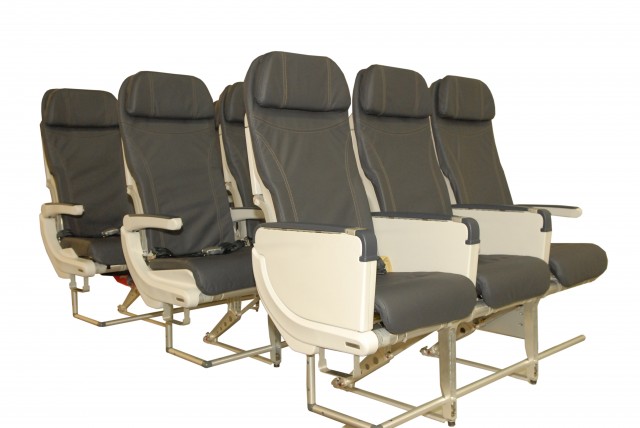
Alaska Airlines new New Recaro seats for economy class that will make their appearance on the airline's new Boeing 737-900ERs. Image from Alaska.
Alaska Airlines has announced that they will be installing new seats from Recaro Aircraft Seating on their 22, soon-to-be delivered, Boeing 737-900ERs.
The seats will offer a six-way adjustable headrest, three inches of recline and an additional inch of legroom.
The additional leg room will not affect the airline’s seat pitch of 31-32″, but it will offer more room for your legs. “The extra inch we refer to is gained by Recaro’s clever design that effectively adds one more inch of room to your living space, without us moving the seats further apart,” Alaska spokes person confirmed to AirlineReporter.com. “Specific to pitch, our pitch will stay consistent with our current standard 31-32 inches.”
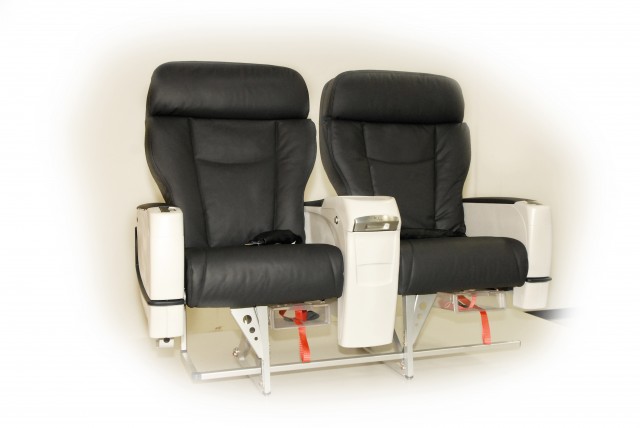
Alaska Airlines new New Recaro seats for First Class that will make their appearance on the airline's new Boeing 737-900ERs. Image from Alaska.
Alaska will also get new Recaro seats for the first class cabin that will offer five inches of recline, an articulating seat bottom and a six-way adjustable headrest.
The seat, “design includes a comfortable yet slimmer seatback and bottom and a literature pocket located above the tray table,” said Joe Sprague, Alaska Airlines’ vice president of marketing. “The new seats add to a very special onboard experience that all of our customers flying Alaska’s new 737-900ERs will enjoy, including Boeing’s Sky Interiorwith its improved lighting and sculpted overhead bins that create a more spacious cabinonboard Wi-Fi, Starbucks coffee, premium Washington wines and delicious meals for purchase, as well as our renowned personal service.”
The seats are also lighter and are expected to save about 8,000 gallons of fuel annually per aircraft.

Allegiant MD-80 and Spirit Airbus A319 hanging out in Las Vegas. Photo by Joe (JX).
With Spirit Airlines raising their carry-on fee at the gate to $100 ($35 if you pay ahead of time after November 6th) and Allegiant Air starting to charge for their carry-ons, it has a bunch of people very upset. But why? If an airline comes out with a policy you do not agree on, do not fly them. They will get the message and either change their policies or go out of business. Even though people state they won’t fly either airline, both Allegiant and Spirit continue to grow, so why would they want to reverse their fees?
Yes, I realize that some passengers do not have many choices at their closest airport. However, there is a reason why other airlines are not able or willing to fly into those airports — they can’t make it profitable. So, you are either stuck with an airline that charges fees, one that runs turbo-props or you take the bus.
What interests me are the people that do have a choice, complain about fees, yet continually choose either of the two ultra low-cost carriers.
Being human, most people want their cake and eat it too. Passengers want a first class experience at an ultra low-cost carrier price. Sorry to break it to you — that is not going to happen.
When asked how Spirit Airlines views its fees, Misty Pinson, Director of Spirit Communications, told AirlineReporter.com, “Our ultra low fares with optional add-ons are very consumer friendly. We give customers the opportunity to save money with our low fares and give them the power to choose the extras they want, and they only pay for those they use rather than being forced into paying a higher fare that includes extras that they don’t even want or use.”
Some of you might be rolling your eyes thinking that Spirit is just spinning the fees as a good thing, but Pinson actually gives some good points. If I fly on another airline that might not have as many fees, but I don’t want a soda, I don’t have a bag to check and I am not interested in food, I am still paying for all of those things in my ticket price. Yet airlines, like Spirit, give you the option to pay less overall, if you are not going to use all the options. How is that unfair? Especially when you do all all the fees to the base fare, the overall price still comes under most other airlines.
I also reached out to Allegiant to check in on charging for carry-on bags is going. “Inevitably, when you start to charge for something that used to be free, there will be some people who are vocal about it, but ultimately, we have seen that only about a third of our customers are purchasing overhead bin space when they make their travel reservations online,” Allegiant spokesperson explained over email. “As we unbundle our product and drive down base fares, we are able to stimulate demand and see growth in the number of people who can afford to travel.”
Let’s take a closer look at how both airlines have been doing; comparing the first quarter of 2011 to 2012, both airlines did very well (all data from SEC):
ALLEGIANT
Revenue Passenger Miles (RPM) are up 17.2%
Passenger revenue is up 25.8%
Average fare is up 6.7% to $94.95
Average fare (ancillary revenue) is up 4.2% to $37.75
SPIRIT
RPMs are up 18.8%
Passenger revenue is up 17.5%
Average fare per passenger flight segment is down 6.9% to $76.65
Non-ticket revenue per passenger flight segment is up 21.3% to $51.68
That 6.9% decrease is important to note. It indicates that the people who don’t buy anything else are getting a better deal on Spirit flights.
If you were an airline and wanted to make profit (when it comes down to it, that is what every airline wants right?) and you have this business model that makes you profit, while you continue to grow your passenger load, why wouldn’t you do it? There is obviously enough demand for airlines like Allegiant and Spirit to exist with other domestic carriers Southwest, Alaska and Virgin America as well.
Many feel that ultra low-cost carriers have started a race to the bottom for overall experience. I disagree. They have provided a cheaper option for people who care more about getting from point A to point B as cheaply as possible than they do about amenities. If you want to ride in style, you can still pay more to fly in first class on another airline, not have to pay any fees, get more room and even a meal. The “golden-age” style of flying still exists, but it will just cost you much more (like it did in the “good ol days”).
If you are still angry about all those airline fees, it is okay to be angry — just don’t blame the airlines. If you are going to blame anyone, blame those passengers who see them as a better overall deal and create the demand for airlines like Allegiant and Spirit to come along and fill.
Alright, let’s hear it… what do you think of these new/higher airline fees?
A huge thanks to Dan Webb for helping me with these numbers and to Joe (JX) for letting me use his photo.
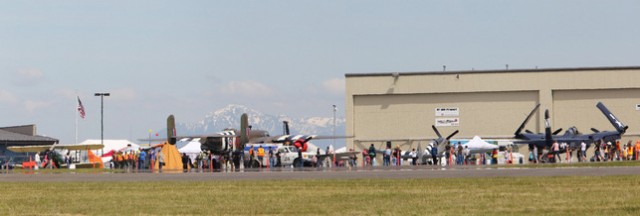
A view of General Aviation Day (now Paine Field Aviation Day) in 2010. Image by Liz Matzelle.
On Saturday, May 19th from 9:00am to 5:00pm, Snohomish County Airport (Paine Field – KPAE) and the Washington Pilots Association ’“ Paine Field Chapter will present Paine Field Aviation Day and you should come.
Admission will be $5 per person or $10 for the entire family. Admission also includes free access to the Flying Heritage Collection and the Historic Flight Foundation. Parking is free and there will be shuttles running from three designated lots throughout the day. The shuttles will drop guests off at the FHC or HFF and there will also be shuttles inside the airport to take guests from one side of the event to the other.
This will be the 17th year that the event is held and provides a bunch of activities:
* FREE YOUNG EAGLES FLIGHTS (KIDS 8-17)
* FIRE FIGHTERS FLY DAY 5K AND PANCAKE BREAKFAST ($5/person ’¢ 9:00am to 11:00am ’¢ benefiting the Northwest Burn Foundation)
* STATIC AIRCRAFT DISPLAYS
* SCENIC HELICOPTER & BIPLANE FLIGHTS (additional cost)
* GREAT FOOD, VENDORS AND KIDS ACTIVITIES
* AVGEEKS FROM AROUND THE GREATER SEATTLE AREA
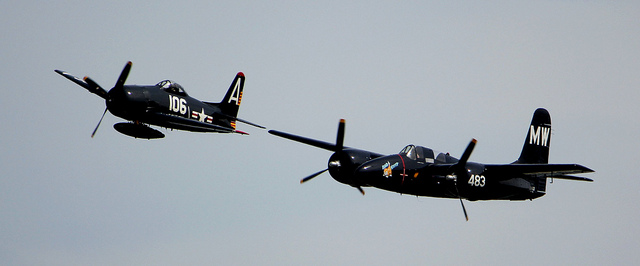
Not all the planes just sit on the ground. F7F Tigercat and F8F Bearcat in formation. Photo by Liz Matzelle.
From the WPA’s press release, “Come see the latest in general aviation aircraft as well as many of the airplanes owned and operated by local private pilots. Vintage aircraft and warbirds will be on display thanks to the participation of the Museum of Flight Restoration Center, Flying Heritage Collection, Historic Flight Foundation and Cascade Warbirds. Among these will be WWII aircraft and many pre-war military and civilian aircraft. Also, in conjunction with the 70th Anniversary of the Doolittle Raid, there will be up to 5 vintage B-25 aircraft on
display. Along with these fascinating and historic aircraft, there will be automobile displays, unlimited hydroplane displays, and some of Paine Field’s fire apparatus will also be on hand for kids to get an upclose look. Beginning at 12:00 pm, the warbirds will take flight, as well as formation flying by The Blackjack Squadron, the Cascade Warbirds and other aviation groups.”
SEE THE OFFICIAL FLYER
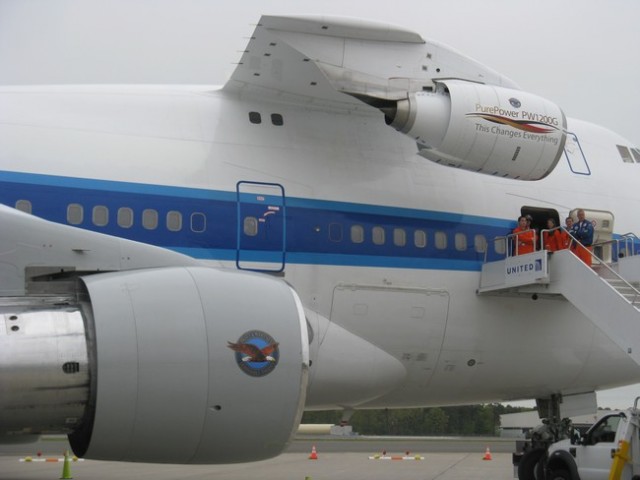
Can you spot what is different about this Boeing 747SP (C-GTFF)? If you guessed the engine attached to the upper deck -- you win. Pratt & Whitney is testing the PW1200G engine. Photo by Guy Norris.
Guy Norris, with Aviation Week, recently posted an interesting story and photos on Pratt & Whitney’s flying test bed – a class Boeing 747SP. P&W is in the process of testing their PW1200G engine, that is slated to for the Mitsubishi Regional Jet (MRJ) and Norris was able to take a tour of the unique and classic aircraft.
P&W uses a Boeing 747SP that was originally delivered to Korean Airlines (reg HL7457) on January 30, 1980. It flew with the airline until it was placed into storage in 1998. Then in 2008, P&W purchased the 747SP to use for engine testing.
Big kudos to P&W for keeping a few rows of first class seats and the mural. For those who dream of the “golden age” of flying, those are the seats you used to fly in. Compare them to some of of the products available today: Emirates Airlines or Singapore Airlines first class product and really, how can you miss the “golden age” that much?
To see more photos and learn more about the testing check out Norris’ story on Aviation Week. Also check out additional photos of the 747SP on Airliners.net.






